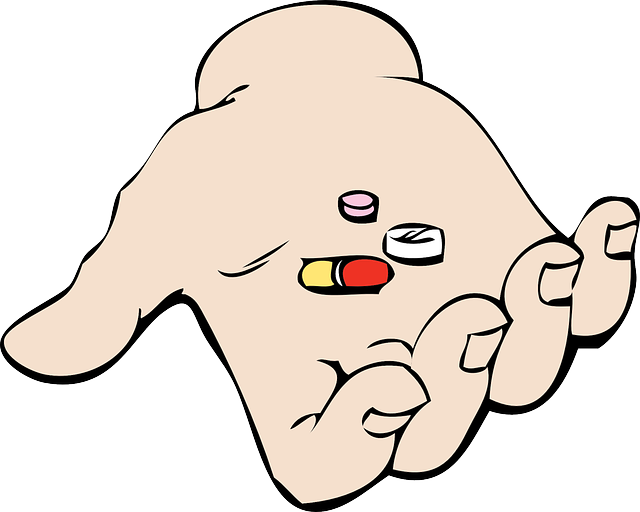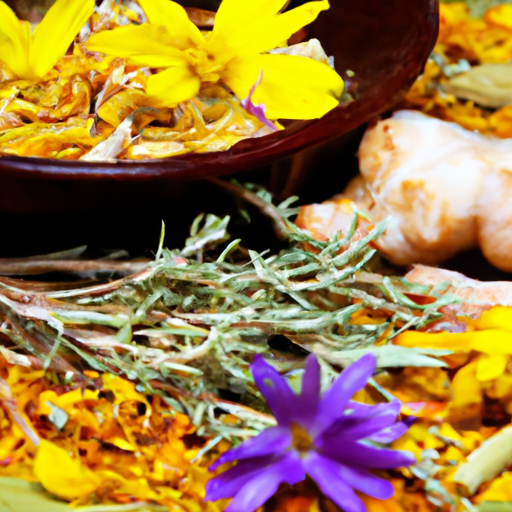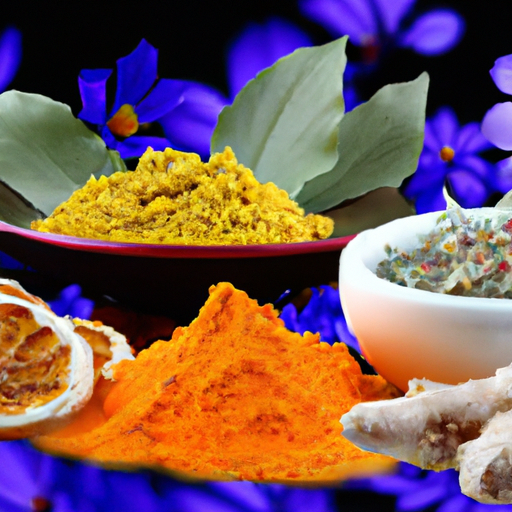Are you tired of relying on over-the-counter medications for pain relief and inflammation? Have you considered trying herbs as a natural alternative? In this article, we will explore some popular herbs that are known for their pain-relieving and anti-inflammatory properties. By the end of this article, you’ll have a better understanding of how these herbs can help manage your pain and inflammation naturally.
One herb that is commonly used for pain relief and inflammation is turmeric. Turmeric contains a compound called curcumin, which has been shown to have powerful anti-inflammatory effects. It can help reduce pain, swelling, and stiffness, making it a great option for those suffering from conditions like arthritis. Turmeric can be consumed in capsule form, added to food as a spice, or drank as a soothing turmeric tea.
Another popular herb for pain relief and inflammation is ginger. Ginger has been used for centuries to treat various health issues, including pain and inflammation. It contains gingerols, which have anti-inflammatory properties. Ginger can be consumed as a supplement, added to food or beverages, or enjoyed as a ginger tea. It’s worth noting that ginger may interact with certain medications, so it’s always a good idea to consult with your healthcare provider before incorporating it into your routine.
These are just a couple of examples of the many herbs available for pain relief and inflammation. In the rest of this article, we will delve deeper into the benefits of these herbs and explore other options that may be suitable for your specific needs. Stay tuned to learn more about how you can find relief from pain and inflammation using the power of herbs.
What Causes Pain and Inflammation?
Pain and inflammation are common ailments that can greatly impact our daily lives, making it difficult to perform even the simplest of tasks. Whether it’s acute or chronic, pain and inflammation can be caused by a variety of factors. Understanding the root causes of these conditions is essential in finding effective relief. In this article, we will explore the common causes of pain and inflammation, as well as natural herbs and remedies that can provide relief.
Common causes of pain and inflammation
Pain and inflammation can arise from a multitude of causes, ranging from injuries to underlying health conditions. Some of the most common causes include:
-
Injuries: Sprains, strains, fractures, and other physical traumas can lead to pain and inflammation. These injuries can occur during sports activities, accidents, or even simple everyday movements.
-
Arthritis: This chronic condition affects millions of people worldwide and can result in joint pain and inflammation. Osteoarthritis and rheumatoid arthritis are the most common forms of arthritis.
-
Autoimmune disorders: Conditions such as lupus, multiple sclerosis, and fibromyalgia can cause widespread pain and inflammation throughout the body.
-
Overuse or repetitive strain: Engaging in repetitive activities, such as typing or playing musical instruments for extended periods, can lead to pain and inflammation in the affected areas.
-
Infections: Infections caused by bacteria, viruses, or fungi can trigger an inflammatory response, resulting in pain and discomfort.
Understanding the inflammatory response
Inflammation is a natural bodily response to injury or infection. When tissues are damaged or infected, the body releases chemicals that attract immune cells to the affected area. These immune cells work to repair the damage and fight off any infection.
While acute inflammation is a necessary process for healing, chronic inflammation can lead to prolonged pain and tissue damage. Chronic inflammation has been linked to various health conditions, including heart disease, diabetes, and certain types of cancer. It is essential to manage inflammation to prevent further complications.
Impact of chronic pain and inflammation on daily life
Chronic pain and inflammation can significantly impact a person’s quality of life. They can limit mobility, disrupt sleep patterns, and even affect mental health. Constant pain and discomfort can make it challenging to engage in daily activities, leading to frustration and decreased productivity.
Finding effective remedies for pain relief and inflammation management is crucial to improving overall well-being and restoring normalcy to one’s life. Natural herbs and supplements have long been used to alleviate discomfort and promote healing. Let us explore some of these herbal options.
Natural Herbs for Pain Relief
Turmeric: A powerful anti-inflammatory herb
Turmeric has been used for centuries in traditional medicine for its potent anti-inflammatory properties. The active component in turmeric, called curcumin, has been extensively studied for its ability to reduce inflammation and alleviate pain. Consuming turmeric or using it topically can provide relief from conditions such as arthritis, muscle sprains, and even respiratory issues.
Ginger: Soothing pain and reducing inflammation
Ginger is a versatile herb known for its anti-inflammatory and analgesic properties. It has been used for centuries to soothe various types of pain, including headaches, menstrual cramps, arthritis, and muscle soreness. Ginger can be consumed as a tea, added to dishes, or used topically for localized pain relief.
Boswellia: Traditional herb for joint pain relief
Boswellia, also known as Indian frankincense, is a herb commonly used in Ayurvedic medicine to address joint pain and inflammation. The resin from the Boswellia tree contains anti-inflammatory compounds that can inhibit the production of inflammatory chemicals in the body. It is often used as a supplement or in topical creams for targeted relief.
White willow bark: Natural alternative to aspirin
White willow bark has been used for centuries as a natural remedy for pain and inflammation. The bark contains salicin, which the body converts to salicylic acid, the active ingredient in aspirin. White willow bark can provide relief from conditions such as headaches, backaches, and osteoarthritis.
Herbal Supplements for Reducing Inflammation
Devil’s claw: Relieving joint and muscle pain
Devil’s claw is a South African herb that has long been used to alleviate joint and muscle pain. It contains compounds that have been shown to possess anti-inflammatory and analgesic properties. Devil’s claw is available in various forms, including capsules, extracts, and topical creams.
Bromelain: Reducing swelling and inflammation
Bromelain is an enzyme found in pineapple that has been shown to have anti-inflammatory properties. It can help reduce swelling and pain associated with conditions such as arthritis and sports injuries. Bromelain is available in supplement form and can be taken orally or applied topically.
Cat’s claw: Balancing the immune system
Cat’s claw, also known as Uncaria tomentosa, is a vine native to the Amazon rainforest. It has been traditionally used to boost the immune system and reduce inflammation. Cat’s claw contains compounds that can help modulate the immune response, making it beneficial for conditions such as arthritis and autoimmune disorders.
Stinging nettle: Alleviating allergic reactions
Stinging nettle is a herb commonly used to alleviate allergy symptoms, such as sneezing and itching. It also possesses anti-inflammatory properties that can provide relief from conditions such as arthritis and joint pain. Stinging nettle can be consumed as a tea or taken in supplement form.
Essential Oils for Pain Management
Lavender oil: Calming properties for pain relief
Lavender oil is well-known for its calming and relaxing properties, but it can also be beneficial for pain management. It has been used to alleviate headaches, muscle pain, and even menstrual cramps. Lavender oil can be applied topically or used in aromatherapy for its soothing effects.
Peppermint oil: Cooling effect on sore muscles and headaches
Peppermint oil has a cooling effect that can provide relief for sore muscles and headaches. It contains menthol, which has analgesic properties and can help relax muscles. Peppermint oil can be diluted and applied topically or used in aromatherapy for its invigorating scent.
Eucalyptus oil: Soothing muscle and joint pain
Eucalyptus oil is commonly used for its refreshing scent, but it also possesses analgesic and anti-inflammatory properties. It can be beneficial for relieving muscle and joint pain, as well as reducing inflammation. Eucalyptus oil can be diluted and applied topically or used in steam inhalation.
Chamomile oil: Anti-inflammatory and calming effects
Chamomile oil is known for its anti-inflammatory and calming effects. It can help alleviate muscle spasms, joint pain, and even digestive issues. Chamomile oil can be diluted and applied topically or used in aromatherapy for its relaxing scent.
Traditional Chinese Herbs for Pain and Inflammation
Corydalis: Used for pain relief and relaxation
Corydalis is a herb commonly used in traditional Chinese medicine for its pain-relieving and sedative properties. It has been used to alleviate menstrual cramps, headaches, and even stomach pain. Corydalis is often consumed as a supplement or brewed into a tea.
Turmeric root: Traditional remedy for joint pain
In traditional Chinese medicine, turmeric root has long been used as a remedy for joint pain and inflammation. It is believed to improve blood circulation and promote healing. Turmeric root can be consumed as a tea or added to dishes for its health benefits.
Chinese skullcap: Reducing inflammation and promoting healing
Chinese skullcap is a herb that has been used in traditional Chinese medicine for its anti-inflammatory and antioxidant properties. It can help reduce inflammation and promote healing. Chinese skullcap is available in supplement form or can be brewed into a tea.
Holistic Approaches to Pain and Inflammation Management
Acupuncture: Stimulating the body’s natural healing processes
Acupuncture is an ancient Chinese practice that involves inserting thin needles into specific points on the body. It is believed to stimulate the body’s natural healing processes and promote pain relief. Acupuncture has been used to alleviate various types of pain, including arthritis, back pain, and migraines.
Meditation and mindfulness: Reducing stress-related pain and inflammation
Meditation and mindfulness practices have been shown to reduce stress levels, which can in turn help reduce pain and inflammation. By focusing on the present moment and adopting relaxation techniques, individuals can alleviate the physical and mental effects of chronic pain.
Yoga and stretching exercises: Promoting flexibility and relieving pain
Yoga and stretching exercises can help promote flexibility, improve posture, and relieve pain. Certain yoga poses and stretches target specific areas of the body, providing relief for conditions such as chronic back pain, arthritis, and muscle soreness.
Massage therapy: Alleviating muscle tension and promoting relaxation
Massage therapy is known for its ability to alleviate muscle tension, improve circulation, and promote relaxation. Various massage techniques, such as Swedish massage or deep tissue massage, can provide relief from pain and inflammation. Massage therapy can be especially beneficial for individuals with chronic pain conditions.
Dietary Modifications for Reducing Pain and Inflammation
Anti-inflammatory foods to include in your diet
Making dietary modifications can play a significant role in managing pain and inflammation. Including anti-inflammatory foods in your diet can help reduce the overall inflammatory response in the body. Some examples of anti-inflammatory foods include fatty fish (such as salmon and sardines), fruits and vegetables, whole grains, nuts, and seeds.
Foods to avoid or limit to reduce inflammation
Just as there are foods that can help reduce inflammation, there are also foods that can contribute to increased inflammation. It is essential to avoid or limit the consumption of processed foods, refined sugars, trans fats, and excessive alcohol. These foods can trigger an inflammatory response in the body and worsen pain and discomfort.
Importance of hydration in pain management
Staying hydrated is vital for overall health and can also play a role in pain management. Adequate hydration helps maintain joint health, supports proper digestion, and aids in detoxification. It is recommended to drink plenty of water throughout the day and limit or avoid sugary beverages.
Lifestyle Changes for Pain Relief
Maintaining a healthy weight to reduce joint pain
Maintaining a healthy weight is crucial for joint health, as excess weight can put added stress on the joints and lead to pain. Engaging in regular physical activity and adhering to a balanced diet can help manage weight and alleviate joint pain.
Regular exercise and physical activity for pain management
Regular exercise and physical activity can be beneficial for pain relief by promoting blood circulation, strengthening muscles, and improving flexibility. Low-impact activities such as walking, swimming, and tai chi can be particularly helpful for individuals with chronic pain conditions.
Improving sleep quality to alleviate pain and inflammation
Poor sleep quality can exacerbate pain and inflammation. It is important to establish a regular sleep routine and create a sleep-friendly environment. Incorporating relaxation techniques, such as meditation or the use of essential oils, can also contribute to better sleep quality.
Supplemental Therapies for Pain and Inflammation
Heat and cold therapy: Alternating temperatures for pain relief
Heat and cold therapy can provide temporary relief from pain and inflammation. Applying a heat pack or warm towel can help relax muscles and promote blood flow, while using a cold pack or ice pack can numb the area and reduce swelling. Alternating between heat and cold can further enhance pain relief.
Topical creams and ointments for localized pain
Topical creams and ointments can provide localized relief for pain and inflammation. Many of these products contain herbal ingredients, such as arnica or menthol, which have anti-inflammatory and analgesic properties. They can be applied directly to the affected area for targeted relief.
Transcutaneous electrical nerve stimulation (TENS): Providing pain relief through electrical impulses
Transcutaneous electrical nerve stimulation (TENS) is a therapy that involves the use of low-voltage electrical currents to provide pain relief. By stimulating the nerves, TENS can help reduce pain signals to the brain and promote the release of endorphins, the body’s natural painkillers. TENS devices can be used at home with the guidance of a healthcare professional.
Conclusion
When it comes to managing pain and inflammation, exploring natural remedies and non-pharmaceutical alternatives can provide effective relief. From herbal supplements and essential oils to holistic approaches and dietary modifications, there are various options to consider. However, it is essential to remember that everyone’s body is different, and what works for one person may not work for another. It is always advisable to consult with a healthcare professional before starting any new treatment regimen. By taking a holistic approach to pain relief and inflammation management, you can find the relief you need to live a more comfortable and fulfilling life.





